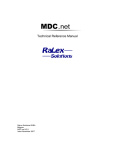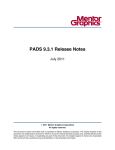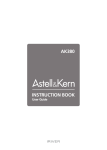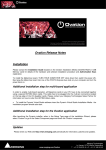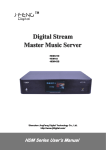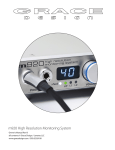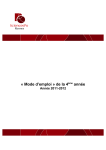Download apt-X Evaluation CoDec. User Manual
Transcript
apt-X Evaluation CoDec. User Manual Rev 1.0 apt-X Evaluation CoDec Issue Index Rev 1.0 ………………………………………………….. Original Release. 1 Rev. 1.0 apt-X Evaluation CoDec Overview The apt-X Evaluation CoDec Module is for encoding and/or decoding one or two channels of digital audio using any of the apt-X algorithms. The algorithms are run on a Motorola 56362 DSP. The module has an S/PDIF audio I/O section and the ability to Sample Rate Convert (SRC) in both directions. Either a Windows ‘G.U.I.’ via USB, or a bank of ‘dip’ switches configures the mode of operation for the module The module also has an expansion header to enable users to interface equipment into the data path at certain points. This gives the ability to bypass some of the on-board components. The power is normally supplied by an external 9v dc supply needing a mains input via an IEC320/C8 lead. (E)apt-X CoDec. Block Diagram of Data Flow and Control Paths Expansion Header Digital Audio In S/PDIF Receiver S/PDIF Transmitter Sample Rate Converter Sample Rate Converter PCM Field Programmable Gate Array (Xilinx) Digital Audio Out +9v d.c. apt-X DSP apt-X Power Sequencing & 3.3v 2.5v generation Oscillators & PLL Circuits USB Connection & Configuration Switches 2 Rev. 1.0 apt-X Evaluation CoDec Getting Started Test 1. This section describes how to configure the module for a simple apt-X loopback. The data flow is as follows; the S/PDIF data is received the PCM data is extracted and supplied to the DSP for encode via the FPGA. The encoded data is then returned to the DSP, again by the FPGA, for decode. The PCM is then routed to the S/PDIF output stage and retransmitted at the same sample frequency (Fs) as the input. This is known as a ‘Low Delay’ mode since the SRCs are not being used, this mode will show the truest latency figures for the algorithm. Before even connecting power to the module, the ‘jumpers’ or links must be set-up. L2 should be set to connect pins 1 and 2. This sets the module to accept configuration from the dip switches. Links J3, J4, J5 and J6 should all have jumpers on them, why this is the case is explained later. The next step is to set the 10-way DIP switch as follows; SW1-1 – On (Loopback) SW1-2 -- Off SW1-3 -- On SW1-4 -- Off SW1-5 -- Off SW1-6 -- Off SW1-7 -- Off SW1-8 -- Off SW1-9 -- On SW1-10 – Off The module is now configured for Eapt-X16, low delay loopback at Fs = 44.1kHz. Once this configuration is set, powering on the module will set the unit up to take in a stereo S/PDIF stream with an Fs of 44.1kHz, encode and decode it. Then return it out the S/PDIF out port. A CD player is an ideal source for this first test. Test 2. The next logical step is to loopback the data at the expansion header where it can be examined as it goes past. To do this only requires one switch to be changed, SW1-1. Setting it to the Off position removes the loopback of the encoded data inside the FPGA, instead the data is routed out via a FIFO to pin 12 of the expansion header (Cn4). Connecting pin 12 to pin 13 of Cn4 will again loopback the data from the encoder to the decoder. By placing oscilloscope probes on pins 12 and 14 of Cn4 it is possible to ‘see’ the encoded (or compressed) apt-X data and the clock associated with it. The two tests above are the quickest to set up and will prove basic operation of the module; however there are many more modes of operation the module is capable of. How to achieve all of these are described in the following sections, which will explain the differences between ‘Master’ and ‘Slave’ modes as well as how to select between low delay and SRC modes. The configuration is described from the perspective of configuration being done via the PC interface software included with the board. An advanced description of how to achieve all these modes using the DIP switches is included as the last section. 3 Rev. 1.0 apt-X Evaluation CoDec Power Requirements The preferred option is to use the supplied 9v d.c. power supply connected to the input ‘jack’. This will then let the module generate all its required internal voltages; this input remains effective with unregulated input voltages as low as 6.5v. It is recommended that a supply voltage above 9v should not be used. The second option is to power the unit via the expansion header CN4 where 5v, 3.3v, 2.5v and 0v(Gnd) connections are available. These supplied voltages must be regulated and free from noise. When the 3.3v supply is active the LD2 indication will illuminate. This will also illuminate on connection of an active USB cable and is NOT a guarantee of all power supply voltages being correct. The module CANNOT be powered using only the USB. Installing the PC Interface Before the Windows application can be used it is necessary to load the appropriate USB driver files on to the PC. This process only needs to be completed once and is quite simple. Insert the supplied CD into the PC. Ensure that L2, on the module, is set with pins two and three linked. Make sure the USB cable is not connected to the module and then power it up. Connect the USB cable to the module. The PC will now detect the ‘new hardware’ and start the standard windows driver install. When prompted for the location of the driver, browse to the DRIVERS directory on the supplied CD. Copy the apt_eval.exe from the CD onto an appropriate place on the PC, such as ‘Desktop’. Run the apt_eval.exe file. This will now bring up a new window with all the configuration options shown. Using the PC Interface. This method of configuration is using the supplied Windows application via the USB port on the module. To ensure correct operation of this mode L2, on the module, must have pins two and three linked and the DIP switches must all be in the OFF position. Once the module has been set up and powered on, the USB cable can be connected and then the configuration application (apt_eval.exe) can then be opened. When it opens, the application will be in the default mode, as shown. 4 Rev. 1.0 apt-X Evaluation CoDec The first option on the application is Master/Slave, this setting depends on whether the unit is to SLAVE to an external network clock (DTE operation), or is allowed to generate its own network clock for the apt-X data.(DCE operation.) For example to connect two modules back to back, one needs to be a master and the other a slave. However, to connect two modules via a network, both units need to be slaves. If the module is set as a slave the clock supplied must be within 50ppm of the frequency specified for that mode. These frequencies can be found in the appendix. For standalone loop-backs Master mode should be selected. Slave mode cannot be selected with low delay mode this is explained later. Compression Algorithm. This simply selects which of the four apt-X algorithms will be run by the DSP. As the algorithm resolution increases so will the amount of encoded data produced. The encoder and decoder cannot be set for different algorithms. Stereo / Mono. This selects whether both channels of the incoming S/PDIF stream are encoded (Stereo) or just the first channel (Mono). If a mono mode is chosen, the encoder only produces half the apt-X data. Equivalently, the decoder will only receive one channels worth of apt-X data but it will output the same PCM to both channels, this is not inherent to the algorithm but is usually desirable. Data Path. This option has already been demonstrated in the ‘getting started’ section. It controls whether the encoded data is sent out to the expansion header or looped by the FPGA and sent back to the DSP. Autosync Check box. This control only becomes active when the apt-X16 algorithm is selected. This is because Autosync cannot be turned off in the enhanced algorithms. Autosync is a very low overhead embedded code which allows the apt-X stream of data to travel without the need for a framing or word clock. Some very early APT products worked without Autosync as framing information could be recovered from other sources. Non Autosync mode and how to frame it are discussed later. It is recommended that it be left on at all times. Low Delay Mode. This mode can only be used if the unit is configured in Master mode. The low delay is achieved at the cost of bypassing the SRCs in and out of the module. This means the DSP MUST run at 5 Rev. 1.0 apt-X Evaluation CoDec the same Fs as the audio is coming in at. Since the audio comes in at a fixed rate there is no way of slaving the DSP to different network rate without the SRCs. When in ‘Low Delay’ mode the only option available to set is the input sample rate (Fsi). This needs set to ensure good audio quality. SRC Modes. When the SRCs are in circuit the module is much more flexible regarding data rates and clocks. There are now two more options which need set. The first is the audio bandwidth to be encoded and the other is the output rate of the S/PDIF. (Fso) The ‘Audio Bandwidth’ setting determides the sample rate of the DSP and therefore the amount encoded data. For example, assume 16 bit algorithm, stereo mode. At Fs=16kHz the apt-X bit rate will be 128kbps but at Fs=48kHz the apt-X bit rate will be 384kbps. The S/PDIF output rate is self explanatory. Pressing the ‘Configure’ button will send the current settings to the module. If any of the options in the application are changed, the hardware will not be updated until the configuration button is pressed. A summary of the last configuration mode sent is displayed in the application window just above the configure button. If a configuration is rejected by the hardware, a message will be displayed in the middle of the screen stating this. The application will be inactive until the window shown here has been acknowledged. Note: If the module is power cycled, then the application should also be closed and reopened. 6 Rev. 1.0 apt-X Evaluation CoDec Dip Switch Configuration This method is for stand-alone mode, where no PC with a USB port is available. In this mode the module configuration is set by the ten-way DIP switches, that are labelled ‘Configuration’ on the PCB. To enable stand-alone mode the ‘jumper’ on L2 must be moved to link pins one and two. The functionality of each switch is shown in the table below. Switch No 10 9 8 7 6 5 4 3 2 1 Stereo Mono SRC Mode B1 SRC Mode B0 SRC Mode A1 SRC Mode A0 Clock Mode Algorithm Select 1 Algorithm Select 0 A’sync On/Off aptX16 Loop Back The Stereo/Mono switch is Off for Stereo and On for Mono the operational changes are the same as the equivalent radio button group on the windows application. The SRC mode switches 9 to 6 are a little more complex in operation. The function of switches 9 and 8 depend on the settings of switches 7 and 6. If switches 7 and 6 are OFF this means the module is in ‘Low Delay’ mode. The function of switches 9 and 8 are then to set-up the module for the appropriate incoming sample rate. The table below shows the exact settings. Switches 7 & 6 Mode SRC Mode A1 SRC Bypass Off SRC Mode A0 Off Switches 9 & 8 if SRC Bypass selected Mode SRC SRC Mode Mode B1 B0 S/PDIF 48kHz Off Off In S/PDIF 32kHz Off On In S/PDIF On Off 44.1kHz In S/PDIF 48kHz On On In Any other setting of switches 7 and 6 will configure the module for SRC mode. This means that switches 7 and 6 set-up the rate of the S/PDIF output. Switches 9 and 8 are now used to select the audio bandwidth to be encoded / decoded. The table below shows the precise settings for each mode. Switches 7 & 6 Mode SRC Mode A1 S/PDIF 32kHz Out S/PDIF 44.1kHz Out S/PDIF 48kHz Out SRC Mode A0 Switches 9 & 8 if SRC mode selected Mode SRC SRC Mode Mode B1 B0 7kHz Off Off Off On 12kHz Off On On Off 15kHz On Off On On 20kHz On On 7 Rev. 1.0 apt-X Evaluation CoDec Switch 5 is the Master Slave selection. On for Slave and Off for Master. As explained earlier for the PC interface, it is impossible to run the module in ‘Slave’ mode while ‘Low Delay is selected. This is why the PC interface will not allow the user to send that configuration. The DIP switches can be set for this invalid mode but the module will not run properly. If the switch is On then the module is in ‘Slave’ mode. This means the unit needs an external clock at the appropriate rate supplied to it. If the switch is Off, the module is in Master mode and will provide a clock at the data rate. Switches 4 and 3 are used for Algorithm selection. The exact settings are shown below. Mode apt-X 16bit Algorithm Select 1 Off Algorithm Select 0 Off Off On On Off On On Eapt-X 16bit Eapt-X 20bit Eapt-X 24bit Switch 2 controls the use of Autosync when the apt-X16 algorithm is selected. If any other algorithm is selected Autosync can not be turned off so the state of this switch is irrelevant. For apt-X16 if the switch is On then Autosync is On. Switch 1 controls the flow of the apt-X data. If the switch is ON then the data is looped so the DSP decodes what it has just encoded. If the switch is Off then the encoded data goes out to the expansion header and data for decode is expected from the expansion header. Additional Information Since this module has been designed as a platform to show the excellent audio quality properties of the apt-X algorithms, some of the flexibility of use has been omitted in order to achieve the best possible audio quality. One example of this is the use of the precision VCXO’s which enable the module to provide an S/PDIF output with jitter below 2nS (Fs = 48kHz), even if the input jitter is much higher. The penalty of this however, is the low tolerance to clocks which are above or below the frequency specified for any particular mode. The VCXO’s only have a ‘pull’ of 100p.p.m, this is why the clock provided to a module in slave mode, must be accurate and stable. The following pages show the switch settings for all the modes and the associated clocks that are generated / required. The data clock must match the data rate, for example 384kb/s needs a 384kHz clock. The modes highlighted with a grey background are functional, however there is little point running the DSP set for 20kHz when the incoming bandwidth is restricted to 15kHz by the 32kHz incoming sample rate. An electronic copy of the module’s schematic is included on the supplied CD ‘apt-X Eval.SCM’ To view this requires CADSTAR 5.0 or greater, alternatively there is a viewer available FREE at http://www.cadstarworld.com/down_viewer6.asp 8 Rev. 1.0 apt-X Evaluation CoDec SRC SRC SRC SRC Clock Mode Mode Mode Mode Stereo source A1 A0 B1 B0 / Mono Off Off Off Off Off Off Off Off Off Off Off On Off Off Off Off On Off Off Off Off Off On On Off Off Off On Off Off Off Off Off On Off On Off Off Off On On Off Off Off Off On On On Off Off On Off Off Off Off Off On Off Off On Off Off On Off On Off Off Off On Off On On Off Off On On Off Off Off Off On On Off On Off Off On On On Off Off Off On On On On Off On Off Off Off Off Off On Off Off Off On Off On Off Off On Off Off On Off Off On On Off On Off On Off Off Off On Off On Off On Off On Off On On Off Off On Off On On On Off On On Off Off Off Off On On Off Off On Off On On Off On Off Off On On Off On On Off On On On Off Off Off On On On Off On Off On On On On Off Off On On On On On kb/s Function 16 bit Master mode, SRC Bypass, S/PDIF in 48kHz, Stereo 384 Master mode, SRC Bypass, S/PDIF in 48kHz, Mono 192 Master mode, SRC Bypass, S/PDIF in 32kHz, Stereo 256 Master mode, SRC Bypass, S/PDIF in 32kHz, Mono 128 Master mode, SRC Bypass, S/PDIF in 44.1kHz, Stereo 352.8 Master mode, SRC Bypass, S/PDIF in 44.1kHz, Mono 176.4 Master mode, SRC Bypass, S/PDIF in 48kHz, Stereo 384 Master mode, SRC Bypass, S/PDIF in 48kHz, Mono 192 Master mode, SRC, S/PDIF out 32kHz, 7kHz Stereo 128 Master mode, SRC, S/PDIF out 32kHz, 7kHz Mono 64 Master mode, SRC, S/PDIF out 32kHz, 12kHz Stereo 192 Master mode, SRC, S/PDIF out 32kHz, 12kHz Mono 96 Master mode, SRC, S/PDIF out 32kHz, 15kHz Stereo 256 Master mode, SRC, S/PDIF out 32kHz, 15kHz Mono 128 Master mode, SRC, S/PDIF out 32kHz, 20kHz Stereo 384 Master mode, SRC, S/PDIF out 32kHz, 20kHz Mono 192 Master mode, SRC, S/PDIF out 44.1kHz, 7kHz Stereo 128 Master mode, SRC, S/PDIF out 44.1kHz, 7kHz Mono 64 Master mode, SRC, S/PDIF out 44.1kHz, 12kHz Stereo 192 Master mode, SRC, S/PDIF out 44.1kHz, 12kHz Mono 96 Master mode, SRC, S/PDIF out 44.1kHz, 15kHz Stereo 256 Master mode, SRC, S/PDIF out 44.1kHz, 15kHz Mono 128 Master mode, SRC, S/PDIF out 44.1kHz, 20kHz Stereo 384 Master mode, SRC, S/PDIF out 44.1kHz, 20kHz Mono 192 Master mode, SRC, S/PDIF out 48kHz, 7kHz Stereo 128 Master mode, SRC, S/PDIF out 48kHz, 7kHz Mono 64 Master mode, SRC, S/PDIF out 48kHz, 12kHz Stereo 192 Master mode, SRC, S/PDIF out 48kHz, 12kHz Mono 96 Master mode, SRC, S/PDIF out 48kHz, 15kHz Stereo 256 Master mode, SRC, S/PDIF out 48kHz, 15kHz Mono 128 Master mode, SRC, S/PDIF out 48kHz, 20kHz Stereo 384 Master mode, SRC, S/PDIF out 48kHz, 20kHz Mono 192 kb/s kb/s 20 bit 24 bit Loopback Loopback Loopback Loopback Loopback Loopback Loopback Loopback Loopback Loopback Loopback Loopback Loopback Loopback Loopback Loopback * * * * 240 288 120 144 320 384 160 192 480 576 240 288 * * * * 240 288 120 144 320 384 160 192 480 576 240 288 * * * * 240 288 120 144 320 384 160 192 480 576 240 288 Items commented with * are invalid modes Rev. 1.0 9 apt-X Evaluation CoDec SRC SRC SRC SRC Clock Mode Mode Mode Mode Stereo source A1 A0 B1 B0 / Mono On Off Off Off Off Off On Off Off Off Off On On Off Off Off On Off On Off Off Off On On On Off Off On Off Off On Off Off On Off On On Off Off On On Off On Off Off On On On On Off On Off Off Off On Off On Off Off On On Off On Off On Off On Off On Off On On On Off On On Off Off On Off On On Off On On Off On On On Off On Off On On On On On On Off Off Off Off On On Off Off Off On On On Off Off On Off On On Off Off On On On On Off On Off Off On On Off On Off On On On Off On On Off On On Off On On On On On On Off Off Off On On On Off Off On On On On Off On Off On On On Off On On On On On On Off Off On On On On Off On On On On On On Off On On On On On On Function Invalid mode Invalid mode Invalid mode Invalid mode Invalid mode Invalid mode Invalid mode Invalid mode Slave mode, SRC, S/PDIF out 32kHz, 7kHz Stereo Slave mode, SRC, S/PDIF out 32kHz, 7kHz Mono Slave mode, SRC, S/PDIF out 32kHz, 12kHz Stereo Slave mode, SRC, S/PDIF out 32kHz, 12kHz Mono Slave mode, SRC, S/PDIF out 32kHz, 15kHz Stereo Slave mode, SRC, S/PDIF out 32kHz, 15kHz Mono Slave mode, SRC, S/PDIF out 32kHz, 20kHz Stereo Slave mode, SRC, S/PDIF out 32kHz, 20kHz Mono Slave mode, SRC, S/PDIF out 44.1kHz, 7kHz Stereo Slave mode, SRC, S/PDIF out 44.1kHz, 7kHz Mono Slave mode, SRC, S/PDIF out 44.1kHz, 12kHz Stereo Slave mode, SRC, S/PDIF out 44.1kHz, 12kHz Mono Slave mode, SRC, S/PDIF out 44.1kHz, 15kHz Stereo Slave mode, SRC, S/PDIF out 44.1kHz, 15kHz Mono Slave mode, SRC, S/PDIF out 44.1kHz, 20kHz Stereo Slave mode, SRC, S/PDIF out 44.1kHz, 20kHz Mono Slave mode, SRC, S/PDIF out 48kHz, 7kHz Stereo Slave mode, SRC, S/PDIF out 48kHz, 7kHz Mono Slave mode, SRC, S/PDIF out 48kHz, 12kHz Stereo Slave mode, SRC, S/PDIF out 48kHz, 12kHz Mono Slave mode, SRC, S/PDIF out 48kHz, 15kHz Stereo Slave mode, SRC, S/PDIF out 48kHz, 15kHz Mono Slave mode, SRC, S/PDIF out 48kHz, 20kHz Stereo Slave mode, SRC, S/PDIF out 48kHz, 20kHz Mono kb/s 16 bit * * * * * * * * 128 64 192 96 256 128 384 192 128 64 192 96 256 128 384 192 128 64 192 96 256 128 384 192 kb/s 20 bit * * * * * * * * 160 80 240 120 320 160 480 240 160 80 240 120 320 160 480 240 160 80 240 120 320 160 480 240 kb/s 24 bit * * * * * * * * 192 96 288 140 384 192 576 288 192 96 288 140 384 192 576 288 192 96 288 140 384 192 576 288 Items commented with * are invalid modes Rev. 1.0 10











